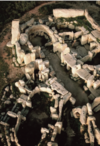1.2: Art in the Stone Age Flashcards
- How does this figure of a woman differ from others created in the Paleolithic period?

Head of a woman (Figure 1-4A). This tiny head is one of the few detailed representations of a human face in Paleolithic art.
- What aspects of the setting for this relief influenced its design?

Reclining Woman (Figure 1-5A). Like the artist who painted the spotted horses of Pech-Merle (Figure 1-9), the Magdeleine sculptor(s) used the natural contours of the cave wall as the basis for the representations. Old Stone Age painters and sculptors frequently and skillfully used the caves’ naturally irregular surfaces—the projections, recessions, fissures, and ridges—to help give the illusion of real presence to their forms.
- What does the location of this suggest in terms of the spread of Neolithic civilization?

House 1 (Figure 1-17A). The site of Skara Brae in the Orkney Islands. It documents the spread of Neolithic civilization to one of the most remote parts of Europe as early as the fourth millennium BCE.
- How do scholars interpret features of this cave painting such as the handprints?

Spotted horses and negative handprints (Figure 1-9). There is no doubt these images had significance for the artists. One speculation is these signs are some form of writing or shorthand identifiers of the cult or community members. The handprint could represent the signature of a cult or community.
- What features of these two works, although in different media, encourage art historians to speculate that they were significant and had a special purpose?

Human with feline (lion?) head (Figure 1-3) and rhinoceros, wounded man, and disemboweled bison (Figure 1-10). They represent three-dimensional and two-dimensional works. Art historians recognize that the sculpture human with feline head was important to its creating group. The time and care taken to carve such a work indicates this was an important object for the community. That same importance is also expressed in the well scene, however, the clear differences in execution point to the differences in identities and the possible interpretations.
- What is one of the suggested functions of this figure?

Nude woman (Figure 1-4). It is thought to possibly represent a fertility figure. This assumption is based upon the exaggerated sexuality of the figurine.
- Although these works were made from different media, what stylistic qualities do they share?

Two bison (Figure 1-6) and Hall of the Bulls (Figure 1-1). Both show profile views. This was important because this view allowed the animal to be fully realized and visualized.
- How does the subject matter differ from the Paleolithic period?

Deer hunt (Figure 1-15). It represents a coherent group of human figures depicted in various styles of motion and movement.
- What “first” does this work represent?

Human figure (Figure 1-14). It marks the beginning of monumental sculpture in Mesopotamia, and it also appeared to be ritually buried.
- How was this work constructed?

Hagar Qim (Figure 1-18). The Maltese builders erected their temples by piling carefully cut stone blocks in courses. To construct the doorways, the builders employed the post-and-lintel system. It has curved and rectilinear forms, which is noteworthy.
- How does the representation of animals differ from other cave paintings? What earlier hypothesis about style does this challenge?

Aurochs, horses, and rhinoceroses, Chauvet Cave (Figure 1-11). It represents a change in the analysis of prehistoric or Paleolithic painting. The aurochs are represented naturalistically, and this has shifted assumptions. It supports the theory of a varied approach to conceiving and depicting animals. Twisted perspective, a convention used to represent animal horns, was a norm in cave paintings, but not the universal format for representation.
- How are animals rendered in Paleolithic paintings?

Namibia animal painting (Figure 1-2). In virtually every painting, animals are represented in strict profile. Profile is the only view of an animal in which the head, body, tail, and all four legs are visible. It is completely informative about the animal’s shape, which is why Stone Age painters universally chose it.


